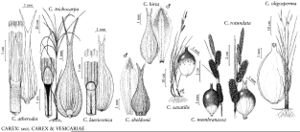Difference between revisions of "Carex atherodes"
Syst. Veg. 3: 828. 1826.
FNA>Volume Importer |
imported>Volume Importer |
||
| (5 intermediate revisions by 2 users not shown) | |||
| Line 8: | Line 8: | ||
}} | }} | ||
|common_names=Carex épi-de-blé | |common_names=Carex épi-de-blé | ||
| + | |special_status={{Treatment/ID/Special_status | ||
| + | |code=W1 | ||
| + | |label= | ||
| + | }}{{Treatment/ID/Special_status | ||
| + | |code=F | ||
| + | |label=Illustrated | ||
| + | }} | ||
|basionyms= | |basionyms= | ||
|synonyms= | |synonyms= | ||
| Line 34: | Line 41: | ||
-->{{#Taxon: | -->{{#Taxon: | ||
name=Carex atherodes | name=Carex atherodes | ||
| − | |||
|authority=Sprengel | |authority=Sprengel | ||
|rank=species | |rank=species | ||
| Line 48: | Line 54: | ||
|publication title=Syst. Veg. | |publication title=Syst. Veg. | ||
|publication year=1826 | |publication year=1826 | ||
| − | |special status= | + | |special status=W1;Illustrated |
| − | |source xml=https:// | + | |source xml=https://bitbucket.org/aafc-mbb/fna-data-curation/src/2e0870ddd59836b60bcf96646a41e87ea5a5943a/coarse_grained_fna_xml/V23/V23_928.xml |
|genus=Carex | |genus=Carex | ||
|section=Carex sect. Carex | |section=Carex sect. Carex | ||
Latest revision as of 20:44, 5 November 2020
Culms hollow, ± spongy near base, trigonous in cross section, 35–125 cm; vegetative culms hollow, flattened when pressed, taller than fertile culms. Leaves: basal sheaths reddish purple, inner bands fibrillose with age; sheaths with apex of inner band pale brown to dull reddish purple, pubescent or scabrous, at least apically, rarely glabrous; ligules (6–)11–45 mm; blades 3–10 mm wide, usually sparsely to moderately long-pubescent, finely papillose abaxially, glabrous adaxially. Inflorescences 12–60 cm; spikes erect or ascending; proximal 2–5 spikes pistillate; terminal (1–)2–6 spikes staminate. Pistillate scales lanceolate to narrowly ovate, apex acute, conspicuously scabrous-awned, glabrous or scabrous near midrib. Staminate scales lanceolate to narrowly ovate, apex obtuse to acuminate, scabrous-awned, glabrous or, rarely, sparsely pubescent. Perigynia 12–21-veined, (6.5–)7–12 × 1.8–3.8 mm, glabrous; beak 2.1–4 mm, glabrous (rarely few spreading hairs on main veins), teeth spreading to outcurved, (1.2–)1.5–3 mm.
Phenology: Fruiting Jun–Aug.
Habitat: Marshes, wet prairies and meadows, open swamps, wet, open thickets, open stream, pond, and lakeshores, ditches, often in water (to 60–80 cm deep)
Elevation: 50–2800 m
Distribution

Alta., B.C., Man., N.W.T., Ont., Que., Sask., Yukon, Alaska, Ariz., Calif., Colo., Idaho, Ill., Ind., Iowa, Maine, Mich., Minn., Mo., Mont., Nebr., Nev., N.Mex., N.Y., N.Dak., Ohio, Oreg., Pa., S.Dak., Utah, Vt., Va., Wash., W.Va., Wis., Wyo., Eurasia.
Discussion
Carex atherodes is a major wetland species in portions of the Midwest and West and becomes increasingly uncommon and local in the eastern portions of its range. It forms large clones and can tolerate deeper water than most Carex. Glabrous forms occur and seem to be more common in the western portion of the range.
Carex atherodes rarely hybridizes with C. trichocarpa.
Selected References
None.
